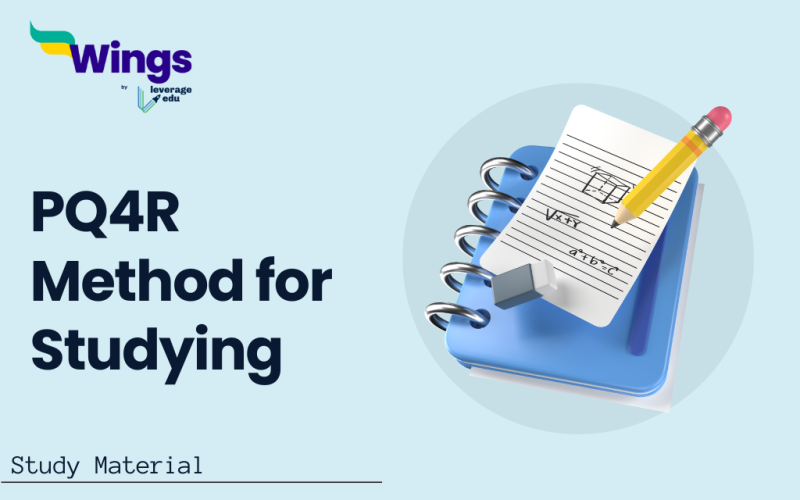Feeling lost while reading lengthy texts? Spending hours in reading yet struggling to retain important concepts? Don’t worry anymore. Here’s where the PQ4R method steps in, a powerful tool to transform passive reading into active knowledge. Studying for any exam demands a planned approach to learning. This six-step strategy goes beyond highlighting and rereading. It actively engages your brain, creating a deeper understanding of complex topics.
| PQ4R Method | PQ4R stands for Preview, Question, Read, Reflect, Recite, and Review. It’s a study method designed to improve reading comprehension and retention through active engagement with the materials. |
| Benefits | 1. Improved understanding of the material 2. More active learning – Improved memory 3. Improved test performance 4. Suitable for different learning styles |
| Challenges | 1. Initial difficulty remembering and consistently applying all steps 2. Difficulty in engaging with the preview step 3. Struggle to make relevant questions 4. Comprehension challenges during reading 5. Difficulty in summarizing and recalling information |
Table of Contents
What is the PQ4R Method?
The PQ4R method offers an approach to learning that increases new content comprehension and memorization. PQ4R is an acronym for read, reflect, recite, preview, query, and review. You should complete the first two steps—preview and question—before starting to read new content for the first time. we have mentioned each of the steps in detail:
- Preview: Become familiar with the chapters. Scan headings, subheadings, introductions, summaries, and visuals. This gives you a roadmap and activates your existing knowledge, making it easier to connect new information.
- Question: Turn those headings into questions! What are the main points? How does this connect to what I already know? Predicting answers creates a focus and purpose for your reading.
- Read: Now, read the text with a critical eye. Take notes, highlight key points, and don’t be afraid to question what you read.
- Reflect: After each section, take a moment to think. How does this information fit with what you already learned? Are there any surprises? Think about the bigger picture and how concepts link together.
- Recite: Test yourself! Explain the material to a friend, record yourself summarizing key points, or create a mind map. Actively pulling information out reinforces what you’ve learned.
- Review: Recap the chapter. Do you understand the main points? Can you answer your initial questions? Refer back to your notes and revisit challenging sections.
Benefits of Using the PQ4R Method for Studying
With PQ4R, you’ll transform from cramming to comprehending. This method has been time-tested by several experts and its efficacy is scientifically proven. The PQ4R method typically offers the following benefits :
- Deeper Understanding: By previewing, questioning, and reflecting, you actively engage with the material.
- Improved Memory: The active recall helps information stick for long-term retention.
- Stronger Critical Thinking: You’ll learn to connect concepts and understand their significance.
- Efficient Studying: PQ4R breaks down the reading process into manageable steps. This focused approach allows you to study smarter, not harder.
- Tackles Complex Texts: By actively engaging with the structure and content, you’ll be better prepared to understand dense information.
PQ4R Method: Not Just for Textbooks!
Don’t try to deal with the whole chapter at once. Break down your reading into manageable chunks and apply the PQ4R method section by section. This powerful strategy isn’t limited to textbooks. You can apply PQ4R to research papers, journal articles, and even dense review materials. Remember that cracking a competitive exam is a marathon, not a sprint. By actively engaging with the material through PQ4R, you’ll be well on your way to revising those textbooks and passing the exams.
Must Read: 7 Habits of Highly Effective People
PQ4R Method Vs SQ3R Method
These methods share similarities in their approach, but PQ4R includes an additional step (“Reflect”) that encourages deeper engagement and understanding of the material. Here’s a comparison table between PQ4R and SQ3R:
| Details | PQ4R Method | SQ3R |
| Acronym | Preview, Question, Read, Reflect, Recite, and Review | Survey, Question, Read, Recite, Review |
| Introduction | Introduced in 1972 by Thomas E.L and Robinson H.A | Popularised by Francis Pleasant Robinson in 1946 |
| Primary Focus | Improves comprehension and memorization | It focuses mostly on comprehension |
| Steps | Preview, Question, Read, Reflect, Recite, and Review | Survey, Question, Read, Recite, Review |
| Additional Step | Reflect | Survey |
FAQs
Preview, Question, Read, Reflect, Recite, Review.
It enhances comprehension by engaging in active reading, encouraging questioning, reflection, and regular review.
Reciting involves summarizing and verbally recalling the main points of what was read, aiding retention and understanding.
PQ4R adds the steps of reflection and recitation, promoting deeper engagement and understanding compared to SQ3R.
This was all about the “PQ4R Method”. For more such informative blogs, check out our Study Material Section, or you can learn more about us by visiting our Indian exams page.
 One app for all your study abroad needs
One app for all your study abroad needs













